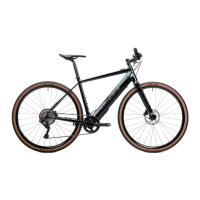GENERAL RIDING INFORMATION
As mentioned, riding a bike, in particular an o-road one, can be dangerous. You must
keep this in mind and be cautious at all times. See and be seen. Use lights and reective
clothing in low light conditions at all times. If the bike is to be used by your child, make
certain that it always wears a suitable and approved bicycle helmet when using the
bike. If your bike has suspension, please be noted that it can alter the way the bicycle
performs.
Riding with a wheel that has not been properly secured can make the wheel wobble or
disengage from the bicycle resulting in serious injury or death.
WARNING: Reectors are not to be used as a substitute for required lights. You should
abide by the local bicycle lighting regulations. Riding at times of poor visibility such
as dawn, dusk, night or others, without a proper bicycle lighting system and reectors
constitutes a hazard and may cause serious injury or death. You should examine the
bike lights and reectors along with their mounting brackets regularly to make sure that
they are clean, straight, unbroken and properly and securely mounted.
WARNING: When your bike is on a bike stand or it’s upside down, never put your nger
or any other part of your body between the chain and the chainring when the wheel
is spinning. It is very easy to have your nger crushed or even amputated in such a
situation!
Always conduct a pre-ride check (detailed information can be found further in this
manual). Never ride the bicycle if you observe any technical problems or have any
doubts about the proper functioning of any element in the bicycle. Keep the bike clean
and well maintained. Make sure that your parts of the body as well as any other objects
do not touch the sharp teeth of the chainrings, chainwheels, sprockets, chain, cranks, or
spinning wheels of your bicycle. While using your bike o-road you are to comply with
the following rules: you need to pay close attention and use the specic skills required
in the changeable conditions and dangers associated with o-road riding. You should
start slowly in uncomplicated terrain and develop your skills gradually. You shouldn’t
ride your bike in remote areas unaccompanied. Even when riding in the company of
others, always let someone know where you’re going and when you expect to come
back. Always keep some sort of identication with you, so that you could be identied
in case of an accident; also you should always have some cash for food, a cold beverage
or an emergency phone call on you. It may be dicult to nd help when you’re riding
o-road. You should abide by the local regulations determining the places and methods
of o-road riding, and respect private property. Respect the rights of the others you may
be sharing the trail with — hikers, equestrians or other cyclists. You should reduce your
impact on the environment to minimum. Thus, never cut your own trails or shortcuts
through vegetation or streams, which could disturb the ecosystem. Don’t ride in mud or
sludge or with unnecessary sliding as such behaviour could contribute to erosion.

